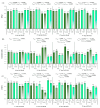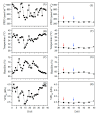Water Stress Promotes Secondary Sexual Dimorphism in Ecophysiological Traits of Papaya Seedlings
- PMID: 40805796
- PMCID: PMC12349495
- DOI: 10.3390/plants14152445
Water Stress Promotes Secondary Sexual Dimorphism in Ecophysiological Traits of Papaya Seedlings
Abstract
Plant genders could express different functional strategies to compensate for different reproductive costs, as females have an additional role in fruit and seed production. Secondary sexual dimorphism (SSD) expression is frequently greater under stress than under optimal growth conditions. The early gender identification in papaya may help to reduce orchard costs because the most desirable fruit shape is formed by hermaphrodite plants. We hypothesized that (a) gender ecophysiological phenotyping can be an alternative to make gender segregations in papaya seedlings, and (b) such gender segregation will be more efficient after a short drought exposure than under adequate water conditions. To test such hypotheses, seedlings of two papaya varieties ('Candy' and 'THB') were exposed to two kind of treatments: (1) water shortage (WS) for 45 h, after which they were well watered, and (2) continuously well-watered (WW). Study assessed the ecophysiological responses, such as stomatal conductance (gs), SPAD index, optical reflectance indices, morphological traits, and biomass accumulation in females (F) and hermaphrodites (H). In WS treatment, the SSD was expressed in 14 of 18 traits investigated, while in WW treatment, the SSD was expressed only in 7 of 18 traits. As tools for SSD expression, gs and simple ratio pigment index (SRPI) must be measured on the first or second day after the imposed WS was interrupted, respectively, while the other parameters must be measured after a period of four days. In some traits, the SSD was expressed in only one variety, or the response of H and F plants were of opposite values for two varieties. The choice of the clearest responses of gender segregation in WS treatment will be greenness index, combination of normalized difference vegetation index (CNDVI), photochemical reflectance index (PRI), water band index (WBI), SRPI, leaf number, leaf dry mass, and leaf mass ratio. If the WW conditions are maintained for papaya seedling production, the recommendation in gender segregation will be the analysis of CNDVI, carotenoid reflectance index 2 (CRI2), WBI, and SRPI. The non-destructive optical leaf indices segregated papaya hermaphrodites from females under both water conditions and eventually could be adjusted for wide-scale platform evaluations, with planned space arrangements of seedlings, and sensor's set.
Keywords: Carica papaya L.; SPAD; SSD; biomass; gender segregation; morphology; optical leaf properties; stomatal conductance.
Conflict of interest statement
The authors declare no conflicts of interest.
Figures








References
-
- Campostrini E., Glenn D.M. Ecophysiology of papaya: A Review. Braz. J. Plant Physiol. 2007;19:413–424. doi: 10.1590/S1677-04202007000400010. - DOI
-
- de Oliveira E.J., Amorim V.B.O., Matos E.L.S., Costa J.L., da Silva Castellen M., Pádua J.G., Dantas J.L.L. Polymorphism of microsatellite markers in papaya (Carica papaya L.) Plant Mol. Biol. Rep. 2010;28:519–530. doi: 10.1007/s11105-010-0180-6. - DOI
-
- De Luca Y., Cozzolino S., Cristaudo A., Widmer A., Cafasso D. Early sex identification by leaflet distance in plantlets of Cycas revoluta. Euphytica. 2024;220:150. doi: 10.1007/s10681-024-03407-1. - DOI
Grants and funding
LinkOut - more resources
Full Text Sources
Research Materials

